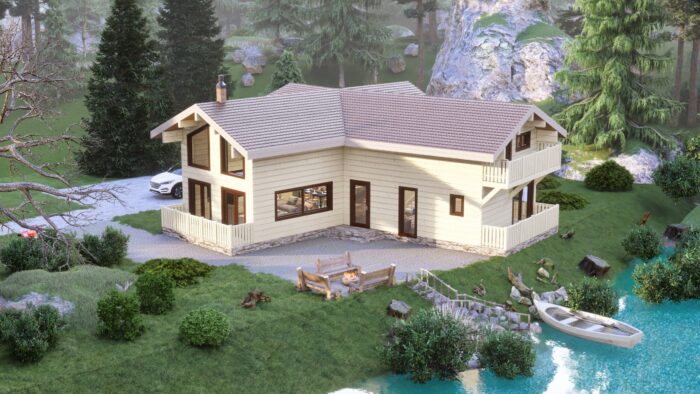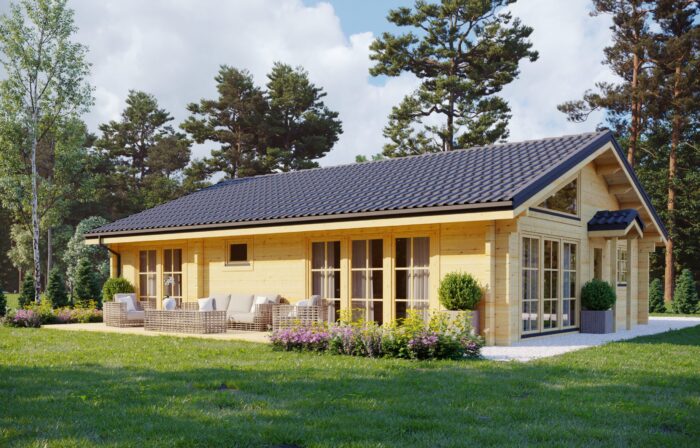Log cabin builders are continually on the lookout for improved materials and components to create safe, energy efficient and hassle free homes. Engineered timber and logs offer almost no checking, with an average moisture content of only nine percent and accept staining and preservative treatments just as readily as solid logs.
Structural Strength
Timber is an attractive natural material with excellent strength and durability properties. Additionally, it can be recycled into something useful while offering visual appeal – all benefits that make natural wood such an appealing resource. However, natural wood has several drawbacks, such as costly upkeep. Engineered timber offers more cost-effective strength, durability, dimensional stability features that outdo its solid counterpart – including being available in various species, sizes, grades for use as joists, floor beams or wall frames.
Log cabin construction relies on materials made from spruce, pine and cedar for their strength and durability, such as their resistance to rot, insect infestations and weathering as well as being lightweight with high tensile strengths and moisture-retaining abilities. These woods also boast excellent moisture control properties.
These materials are less expensive than other structural woods and come in an array of colors and finishes, making them an excellent choice for log cabins and traditional homes alike. Furthermore, their ease of maintenance makes for minimal upkeep costs, creating an inviting environment.
Make sure the material for log cabins you select is certified for its intended use. Manufacturers usually stamp timber with their logo or information and issue a certificate of compliance for your project ensuring it satisfies industry regulations while being properly treated, free from insect damage or contaminants.
Prefabricated timber provides numerous benefits to builders. Not only does it speed up installation time and labor costs, it can also decrease waste on-site. Materials typically arrive to sites in kits for easy assembly – these kits also allow for expansion or modification down the line of construction.
Durability and longevity should be your main concerns when selecting materials for your cabin. Stains with low VOC content will help minimize toxic fume build-up while using breathable coatings on exterior walls can last much longer without needing frequent reapplication.
Durability
Selecting the ideal timber species and construction techniques are integral parts of creating a durable log cabin. Engineered timber is an excellent option as it’s less likely to experience issues like shrinking, settling or warping that compromise durability. Furthermore, engineered wood offers enhanced levels of stability which is especially essential when building on sloped sites like log homes are built.
One of the major advantages of using engineered timber in log cabin construction is its resistance to moisture and mold growth, thanks to an average moisture content of less than nine percent and being made of kiln-dried wood. This process helps prevent moisture damage that leads to mold or mildew growth on wood structures, helping keep log cabin construction as moisture-free as possible.
Kiln-dried timber offers several distinct advantages over traditional lumber in terms of its durability. For instance, it’s less susceptible to checking when not stored correctly and sealed with wood preservatives, while its higher specific gravity makes it better at holding fasteners in place and makes it an excellent choice for use in log homes that experience high levels of compression.
Engineered wood is highly valued for its ability to withstand heavy loads, making it ideal for framing walls and roofs as well as staircases and beams. Engineered timber also often represents an economical alternative to more durable materials like steel or concrete.
Engineered timber products often utilize recycled materials. Some also utilize low-VOC and formaldehyde-free adhesives that minimize environmental concerns, providing a sustainable alternative to solid wood that can be used across numerous applications.
Engineered wood is increasingly becoming the choice of builders of log homes due to its strength, beauty and durability. However, it is essential that any log home be designed so as to prevent air infiltration and moisture absorption – featuring proper ventilation systems as well as sub-flooring structures for support.
Aesthetics
Engineered timbers offer numerous benefits when used for construction purposes, from replicating natural log sizes and styles, to being stronger and more durable than solid wood alternatives. Furthermore, engineered timbers can be manufactured off-site before being delivered ready to install at the build site – saving both time and money by eliminating weather-dependent installations.
Engineered timbers can be formed into various shapes, such as posts and beams with curves, by means of fabrication. Engineered timbers also tend to be more rigid than solid wood structures, helping reduce vibration and movement within buildings – this feature is especially advantageous in log cabins where noise such as creaks can become an annoyance for occupants.
There are various kinds of engineered timber products, with laminated veneer lumber (LVL) being one of the most widely-used examples. This composite wood product is created by bonding thin wood veneers together in a billet to form one long strip whose grain runs along one direction; this increases both its strength and stability. Another popular form is dowel laminated timber (DLT), which uses dowels instead of glue for edge joining; thus eliminating potential VOC emissions into the atmosphere.
Engineered timber offers another advantage of low embodied energy consumption. Traditional home construction uses various materials for insulation purposes – siding, house wrap, drywall, insulation and paints among them – but log and timber homes take advantage of their massive sizes to serve both structural and insulating purposes in one material, significantly decreasing heating and cooling energy demands.
Engineered timber products are generally produced using recycled materials, such as scrap lumber that’s too small for other uses and sawdust or wood chips, combined with resins to form strong, dense wood products that produce less waste than milling solid timbers.
Cost
Engineered timber products offer significant cost savings over their solid counterparts. Engineered timber is more sustainable, helping reduce waste from milling natural timbers. Furthermore, engineered wood products can be produced according to precise design specifications without cutting or splitting natural wood, and many use castoffs from lumber industries and byproducts that help further decrease waste while using less energy to manufacture and thus having reduced environmental impacts than solid products.
Engineered timber products such as plywood are excellent examples of engineered timber products that combine thin wood veneers glued together using heat and pressure, with grain direction alternated in every layer to produce stronger panels with greater stiffness and stiffness. It can be used to add strength, stiffness, stability and structural support for floor, wall or roof framing; cabinet boxes; or stair components.
Engineered timber products such as laminated veneer lumber (LVL) and cross-laminated timber (glulam) are two examples of engineered timber products. LVL is made by bonding thin wood veneers into one billet using heat and pressure; its strength comes from its alternating grain patterns which makes each ply strong and stable. Meanwhile glulam can be found commonly used in bridge and building construction because its moisture absorbency keeps cracks or warping at bay.
Engineered timber has many benefits, yet it also has drawbacks. Variations in moisture content can lead to fungal degradation; this issue can be addressed by drying the timber to an ideal level of 20% moisture content; this will prevent fungal formation while helping ensure structural integrity is not compromised by excess moisture content.
Engineered timber may present environmental concerns. The glues used to make engineered timber products may produce volatile organic compounds during and after production, which are harmful both to people and the environment. Manufacturers have responded by improving production efficiency and developing low-VOC formaldehyde glues.


